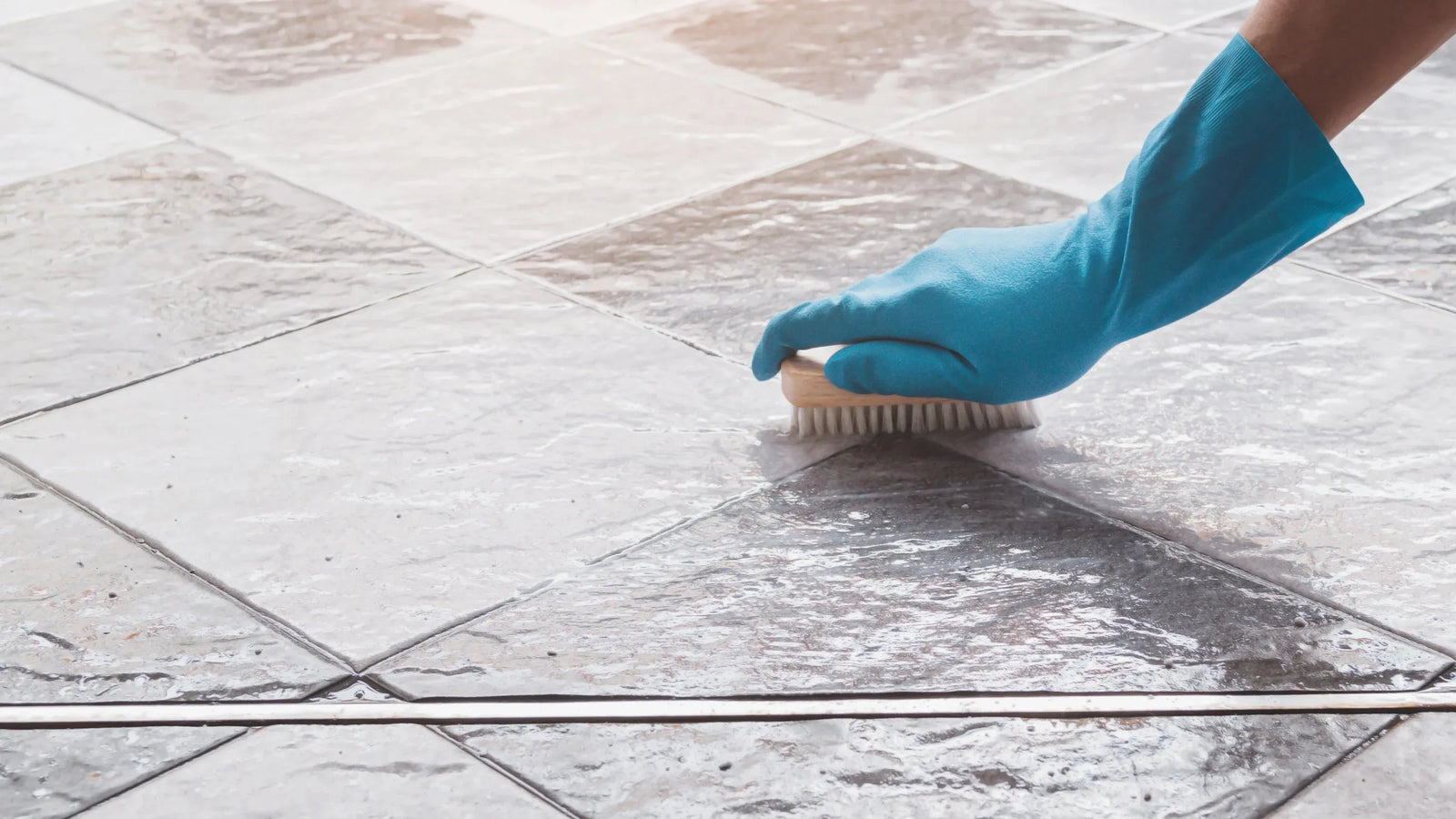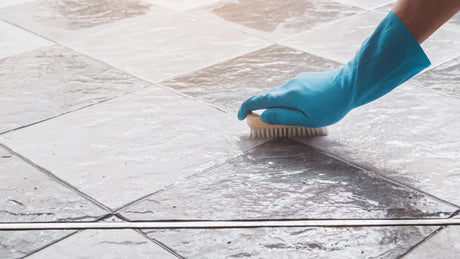Cleaning floor tile grout is essential to maintaining a fresh, polished look in your home. Over time, grout can become stained, discoloured, or even blackened due to dirt, mildew, and everyday wear. But how do you clean floor tile grout effectively without damaging it? In this guide, we’ll explore the best methods and products to restore your grout to its original state.
Key Takeaways
- Use a Multi-Step Approach – Combining natural cleaners, commercial products, and steam cleaning provides the best results for grout maintenance.
- Commercial Cleaners Work Well for Tough Stains – Zep Grout Cleaner is highly effective, but proper ventilation is recommended due to strong odors.
- Steam Cleaning is a Great Chemical-Free Option – It deep cleans grout, kills bacteria, and is safe for most tile surfaces.
- Seal Your Grout After Cleaning – Applying a grout sealer helps prevent future stains and mold buildup, making maintenance easier.
Required Tools
Before you begin, gather the necessary tools to make the process easier and more efficient. Here’s what you’ll need:
• A stiff-bristle grout brush or old toothbrush
• A spray bottle
• Baking soda
• White Vinegar
• Hydrogen peroxide
• Dish soap
• Grout cleaner (commercial or homemade)
• Steam cleaner (optional, for deep cleaning)
• Grout sealer (to protect after cleaning)
Best Grout Cleaners:
1. Baking Soda Paste
- Mix baking soda with water to create a thick paste. The paste acts as a mild abrasive that can remove surface stains without damaging the grout.
- Apply the paste directly to grout lines using a brush or sponge, ensuring full coverage.
- Scrub with a stiff-bristle grout brush in circular motions, focusing on heavily stained areas.
- Rinse with warm water and wipe clean with a cloth.
- Repeat as needed for deep stains.
2. Vinegar and Baking Soda
- Sprinkle baking soda over the grout. This acts as a gentle abrasive to lift dirt.
- Fill a spray bottle with white vinegar and spray directly onto the baking soda. The reaction will create a foaming effect that helps break down grime.
- Let the solution sit for 5–10 minutes to loosen debris.
- Scrub thoroughly with a brush to remove stains.
- Rinse with warm water and dry with a cloth.
- Avoid using vinegar on natural stone tiles as it can cause etching.

3. Hydrogen Peroxide and Dish Soap
- Mix equal parts hydrogen peroxide and dish soap in a small bowl. Hydrogen peroxide acts as a natural whitener, while dish soap helps lift grease and dirt.
- Apply the mixture to grout lines using a sponge or brush.
- Let sit for 10–15 minutes to allow the cleaning agents to penetrate stains.
- Scrub thoroughly, focusing on areas with deep discoloration.
- Rinse well with warm water to remove residue.
- Dry with a clean towel to prevent moisture buildup.
4. Steam Cleaning
- Fill a steam cleaner with water and allow it to heat up according to the manufacturer’s instructions.
- Hold the steam cleaner nozzle close to the grout lines and move it slowly across the surface.
- The high-temperature steam will break down dirt, grease, and bacteria, making it easier to wipe away.
- Use a brush attachment for stubborn stains and scrub lightly.
- Wipe the area dry with a microfiber cloth to remove loosened debris.
- This method is highly effective for deep cleaning without chemicals and is safe for most tile surfaces.

5. Commercial Cleaners
- UltraCare Concentrated Tile & Grout Cleaner this industrial-strength formula is effective at lifting stubborn stains and restoring grout colour. Apply the cleaner to grout lines, let it sit for a few minutes, then scrub and rinse thoroughly. User reviews highlight its ability to remove years of grime with minimal effort. However, some users report a strong odour and recommend good ventilation during use.
- Grout Restorer Pen: Ideal for minor touch-ups, the pen allows for precise application to whiten and refresh grout lines. Simply draw over the grout, allow it to dry, and wipe off excess residue. Users appreciate its ease of use but note that it may not hold up well in high-moisture areas, and the pen nibs can wear out before the product is fully used.

Conclusion
Regular grout maintenance is key to keeping your floors looking clean and fresh. To achieve the best results, it's often beneficial to take a multi-step approach. Start with natural cleaning solutions like baking soda for routine maintenance, but consider using commercial cleaners like Zep for tougher stains. Steam cleaning can be an effective method for deep cleaning without chemicals. Combining different techniques ensures a more thorough clean. Don’t forget to seal your grout after cleaning to keep it protected from future stains and reduce the need for frequent deep cleaning.
What Not to Use on Grout
To prevent damage, avoid using the following:
Bleach: While it whitens, it can weaken grout over time.
Ammonia-based cleaners: Can erode grout and cause discoloration.
Abrasive scrubbing pads: These can wear down grout lines.
Colored cleaning solutions: May stain white or light-colored grout.
How to Clean White Grout
White grout is particularly prone to discoloration due to dirt, soap scum, and moisture exposure. Restoring its brightness requires a combination of cleaning techniques and regular maintenance. Follow these steps to keep your white grout looking fresh:
Hydrogen Peroxide and Baking Soda Mix: Combine equal parts hydrogen peroxide and baking soda to form a thick paste. Apply it to the grout and let it sit for at least 15 minutes before scrubbing with a grout brush. Rinse thoroughly with warm water.
Grout Restorer Pen: A grout restorer pen is an easy solution for whitening grout lines. Simply apply the pen over the grout lines, let it dry, and wipe off any excess.
Oxygen Bleach: Mix oxygen bleach powder with warm water and pour it over the grout. Allow it to sit for 10–15 minutes, then scrub and rinse. Oxygen bleach is less harsh than chlorine bleach and works well for deep cleaning white grout.
Regular Cleaning and Sealing: To prevent future stains, clean grout lines at least once a week using mild soap and water. Apply a grout sealer every six months to create a protective barrier against dirt and stains.
Avoid Harsh Chemicals: Stick to natural or grout-safe cleaners to avoid weakening the grout structure over time.
How to Clean Grout That Has Turned Black
If your grout has turned black, it may be due to mold, mildew, or heavy dirt buildup. Ignoring black grout can lead to further deterioration, making it even harder to clean. Here’s how to restore it:
Steam Cleaner: A steam cleaner is an excellent chemical-free option for deep cleaning and sanitizing grout lines. The high heat breaks down grime and kills mold spores.
Commercial Grout Cleaner: Apply a specialized grout cleaner like Zep, letting it sit for a few minutes before scrubbing with a stiff-bristle brush. This helps lift deep stains and accumulated dirt.
Baking Soda and Hydrogen Peroxide Paste: For a natural alternative, mix baking soda with hydrogen peroxide to form a paste. Apply it to the grout, let it sit for 10–15 minutes, then scrub and rinse.
Rinse and Dry: After scrubbing, rinse thoroughly with warm water and dry with a clean cloth to prevent moisture buildup.
Apply Grout Sealer: Once the grout is clean and dry, apply a grout sealer to prevent mold regrowth and make future cleaning easier.








 https://bessofloor.com
https://bessofloor.com